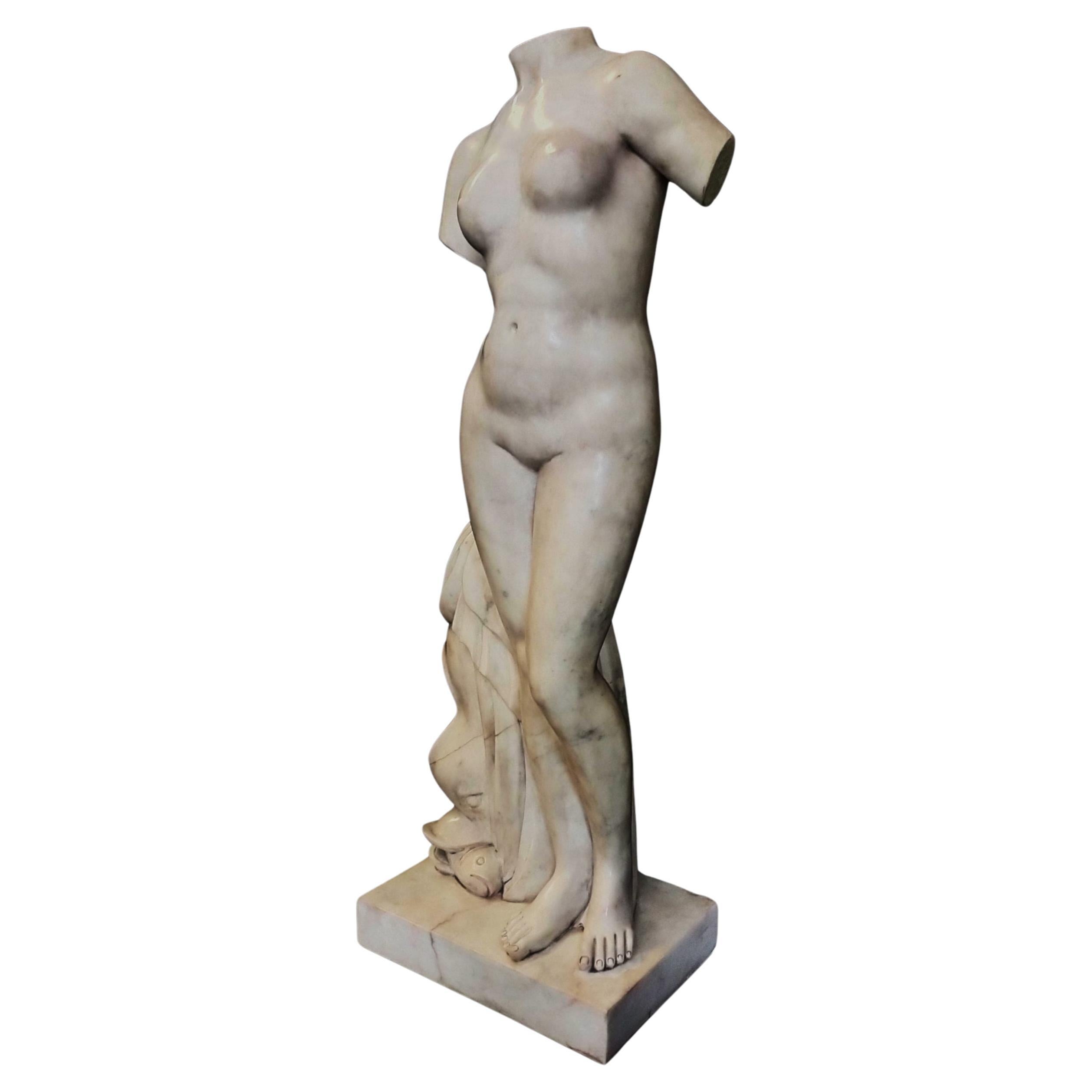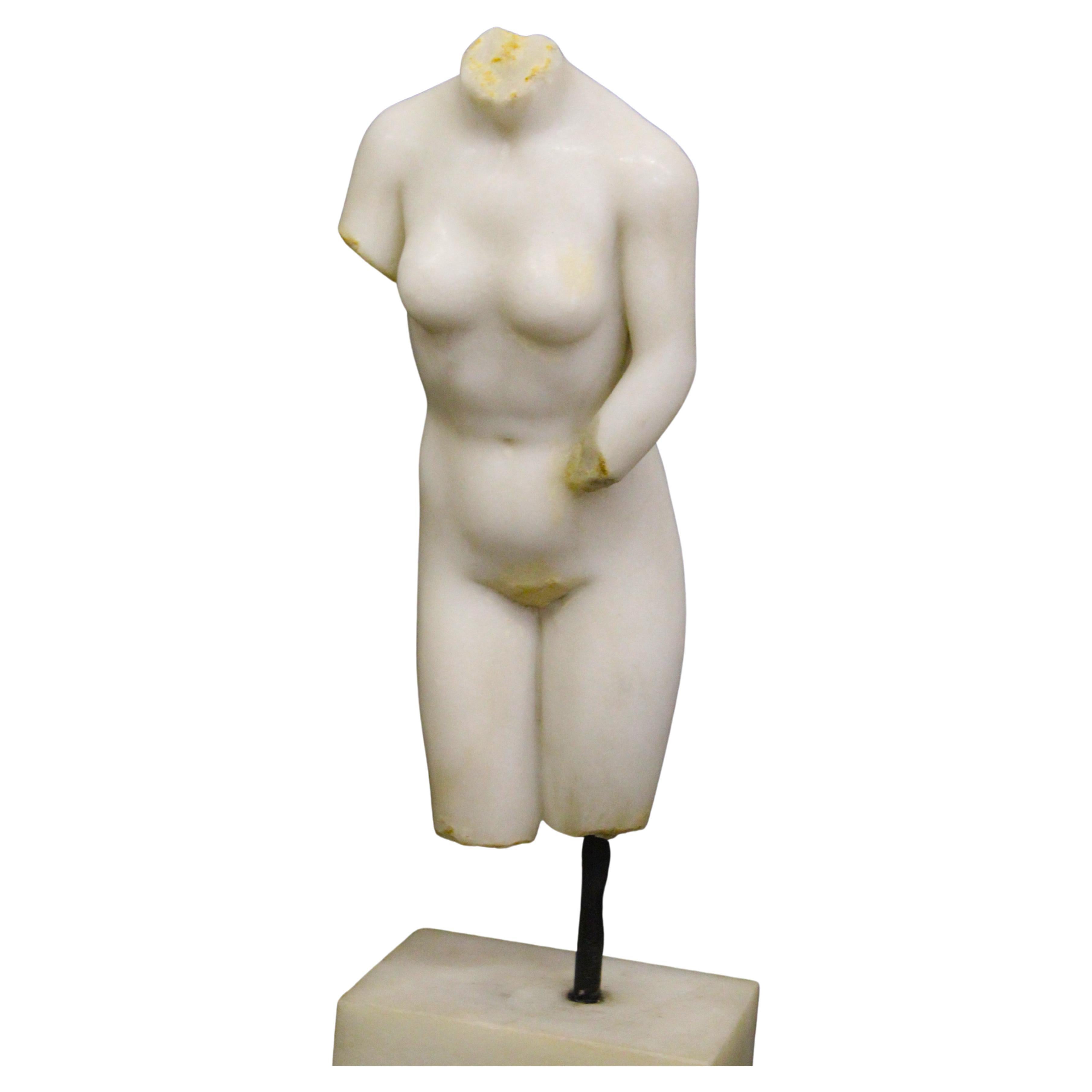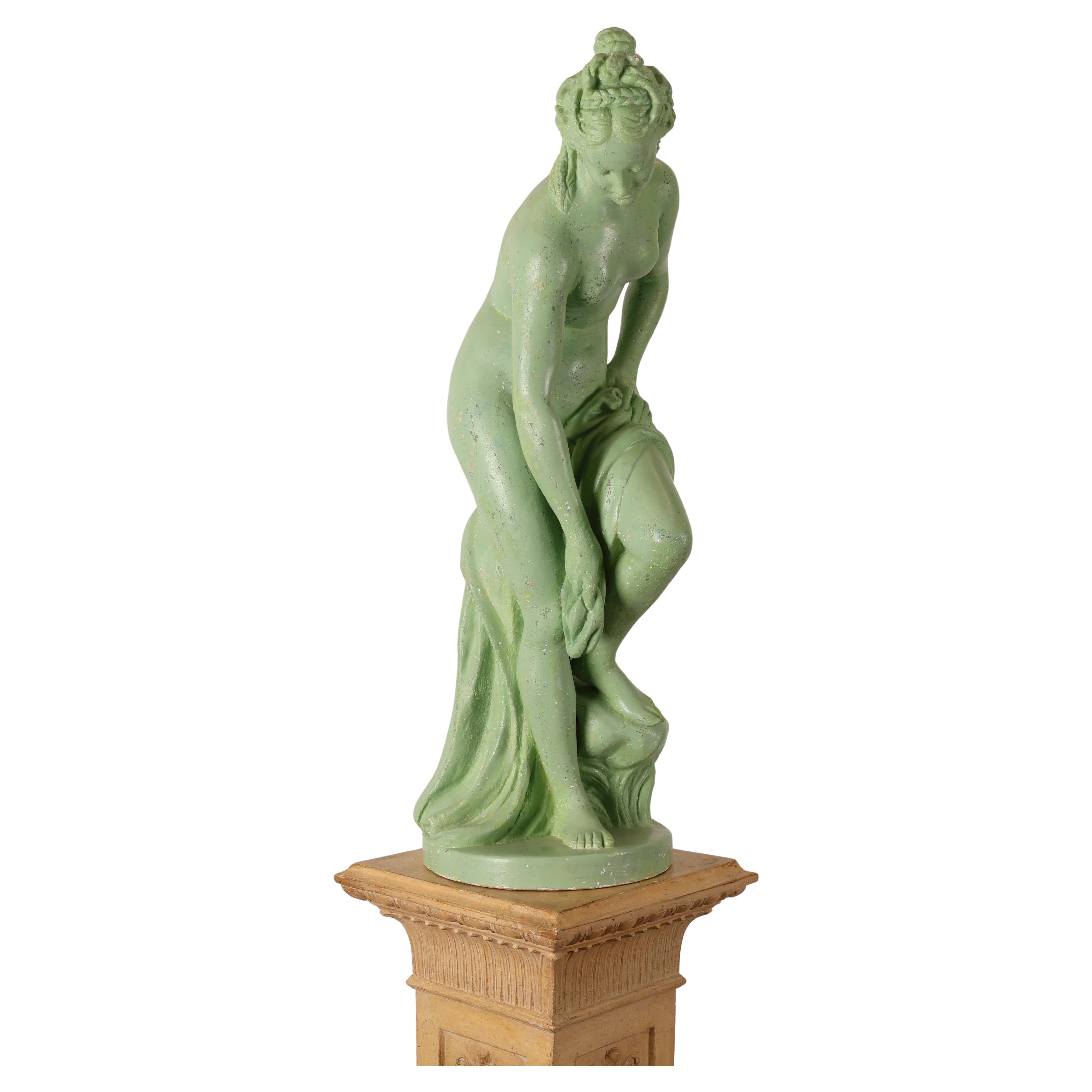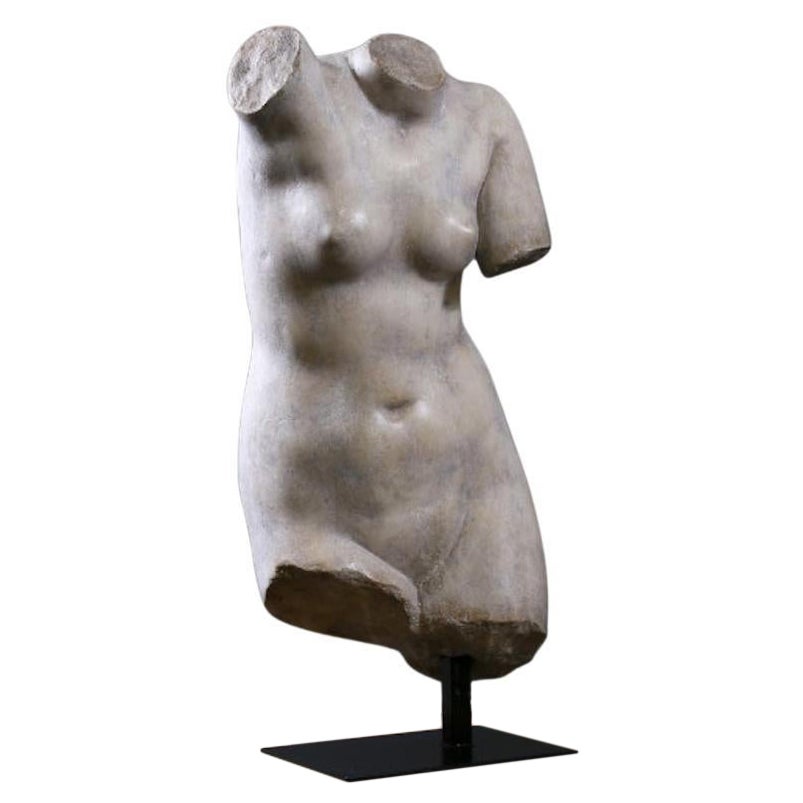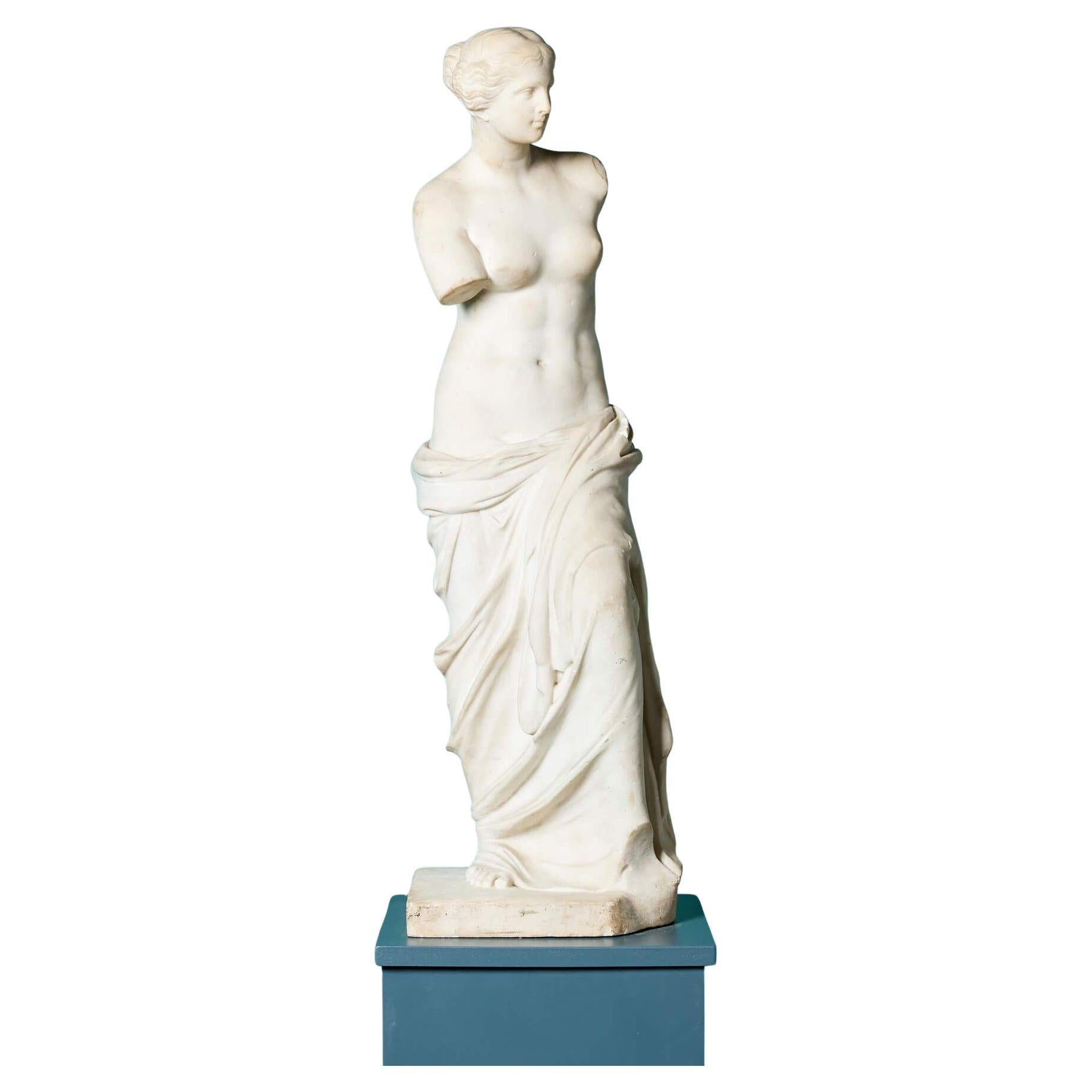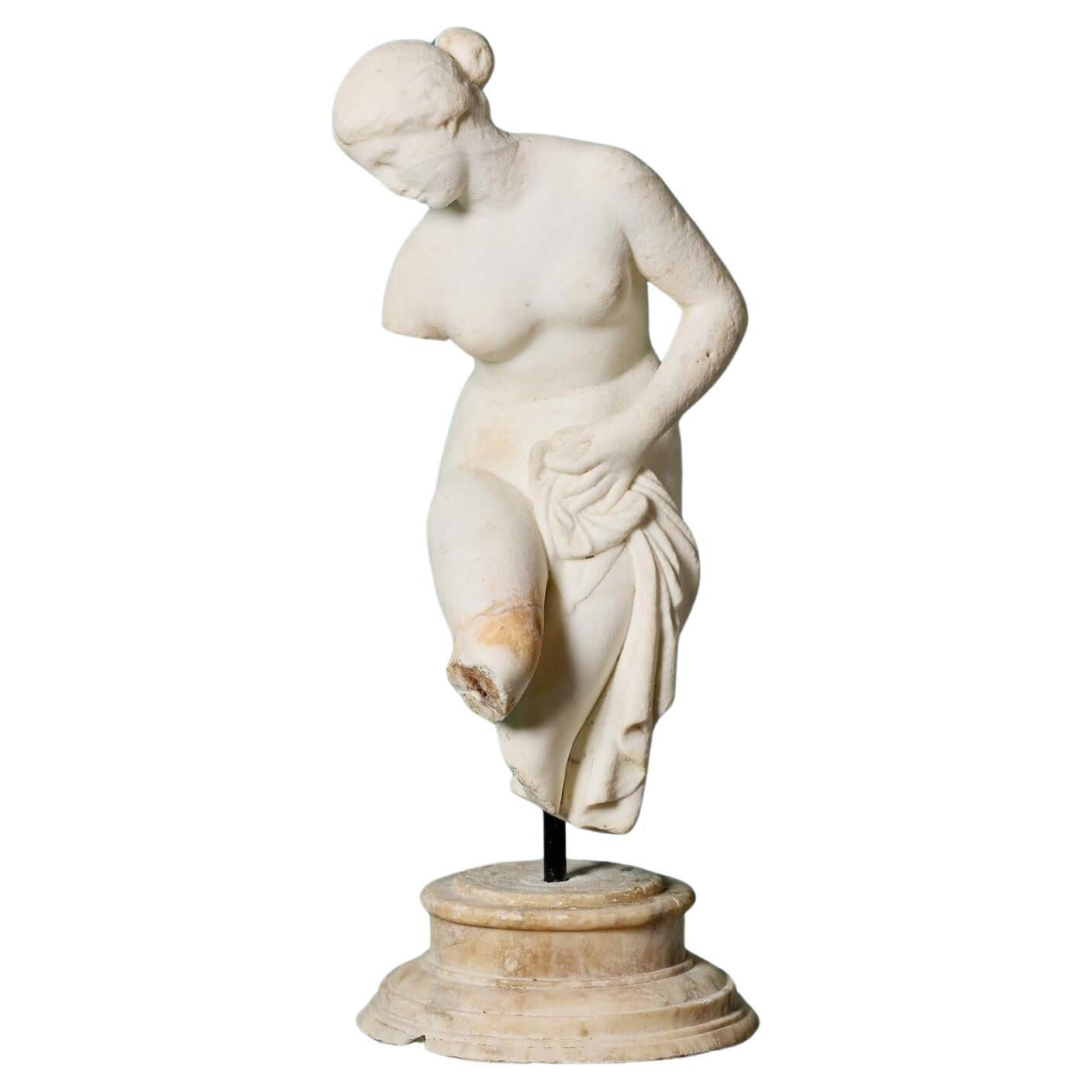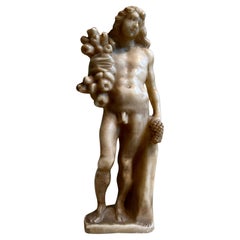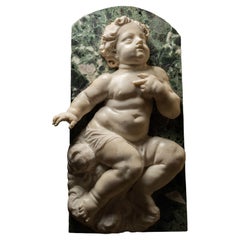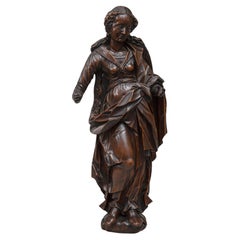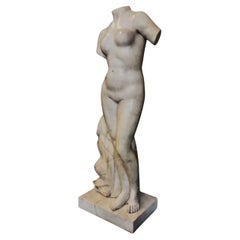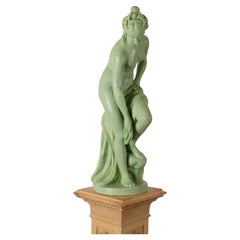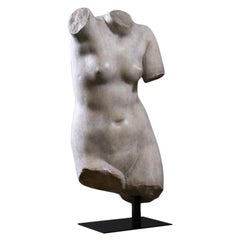Items Similar to Venus Pudica (Medici-type) - 18th century, Italy
Want more images or videos?
Request additional images or videos from the seller
1 of 13
Venus Pudica (Medici-type) - 18th century, Italy
$143,143.66
£104,399.25
€120,000
CA$196,279.02
A$219,151.23
CHF 114,986.30
MX$2,704,713.85
NOK 1,445,392.86
SEK 1,352,421.34
DKK 913,124.74
Shipping
Retrieving quote...The 1stDibs Promise:
Authenticity Guarantee,
Money-Back Guarantee,
24-Hour Cancellation
About the Item
Monumental sculpture representing the Venus Pudica (Medici-type)
18th Century
Italian (Rome)
White marble
Based on a model from Antiquity, the Medici Venus, currently in the Uffizi Gallery in Florence
Height: 100 cm
Width: 42 cm
Depth: 30 cm
H 39 1/3 x W 16 ½ x D 11 7/8 inch
This 18th century marble torso of Venus embodies the epitome of classical beauty and artistic refinement. Beyond its aesthetic appeal, this sculpture holds historical significance, intertwining with the Roman model, housed in the Uffizi Museum, and reflecting the cultural phenomenon of the Grand Tour. Additionally, the influence of the Venus Pudica archetype adds depth to its interpretation and understanding. Let’s delve into these facets, illuminating the rich tapestry of influences that shape the Marble Torso of Venus.
At the heart of the torso of Venus lies its Roman model, a timeless representation of Venus, the goddess of love and beauty, showcased in the prestigious Uffizi Museum. Rooted in antiquity, this sculpture exemplifies the classical ideal, characterized by its harmonious proportions and serene countenance. Drawing inspiration from the Venus Pudica archetype, which portrays the goddess modestly covering herself, the Roman model captivates with its elegance and poise. Through a nuanced analysis, scholars unravel the intricacies of its craftsmanship, marveling at its ability to evoke a sense of ethereal beauty and divine grace. The Marble Torso of Venus pays homage to this esteemed tradition, reinterpreting the classical motif for a contemporary audience while honoring its enduring legacy.
Central to the interpretation of the torso is its connection to the Venus Pudica archetype, which portrays the goddess in a modest pose, covering herself with her hands. This archetype, prevalent in ancient Roman sculpture, symbolizes notions of chastity, purity, and feminine virtue. By incorporating elements of the Venus Pudica into its design, the Marble Torso of Venus transcends mere aesthetic beauty, inviting viewers to contemplate deeper themes of love, desire, and the human condition. This fusion of classical ideals with contemporary sensibilities underscores the enduring relevance of the Venus Pudica archetype and its influence on artistic expression throughout history.
Against the backdrop of the 18th century, the Grand Tour emerged as a rite of passage for European aristocrats and intellectuals, beckoning them to embark on a journey of cultural enlightenment across the continent. Italy, with its rich artistic heritage, served as the ultimate destination, offering travelers an opportunity to immerse themselves in the splendor of antiquity. Amidst this cultural milieu, the Medici-Venus emerged as a beacon of classical beauty, enticing patrons to acquire such masterpieces as souvenirs of their travels. As they adorned their estates with these treasures, they not only showcased their refined taste but also perpetuated a legacy of artistic appreciation for generations to come. The Marble Torso of Venus thus becomes a tangible symbol of the Grand Tour movement, embodying the spirit of cultural exchange and intellectual curiosity.
The Venus de' Medici is a renowned marble sculpture from ancient Greece, celebrated for its depiction of the goddess Venus, also known as Aphrodite. She was sculpted around the 1st century BC during the Hellenistic period, its exact creator remains unknown, though it's believed to be a Roman replica of a Greek original, possibly from the hands of the famed sculptor Praxiteles.
This masterpiece, standing at approximately 155 cm tall, showcases Venus in what's known as the "Medici Venus Type" or "Crouching Venus" pose. With her right arm delicately veiling her modesty and her left hand gracefully adjusting her drapery, the sculpture exudes an aura of feminine beauty, sensuality, and poise.
Named after the influential Medici family of Florence, who owned it during the Renaissance, the Venus de' Medici holds a significant place in art history. Its timeless elegance and idealized proportions have inspired artists for centuries, serving as a model of classical harmony and naturalism. Today, this masterpiece finds its home in the Uffizi Gallery in Florence, where it continues to captivate visitors with its unparalleled beauty and profound cultural significance. As a symbol of grace and aesthetic perfection, the Venus de' Medici stands as a testament to the enduring legacy of ancient Greek art and its enduring influence on Western aesthetics.
- Dimensions:Height: 39.38 in (100 cm)Width: 16.54 in (42 cm)Depth: 11.82 in (30 cm)
- Style:Grand Tour (Of the Period)
- Materials and Techniques:
- Place of Origin:
- Period:
- Date of Manufacture:18th century
- Condition:Wear consistent with age and use.
- Seller Location:Bruxelles, BE
- Reference Number:1stDibs: LU6666239131452
About the Seller
5.0
Vetted Professional Seller
Every seller passes strict standards for authenticity and reliability
1stDibs seller since 2022
15 sales on 1stDibs
Typical response time: 5 hours
- ShippingRetrieving quote...Shipping from: Bruxelles, Belgium
- Return Policy
Authenticity Guarantee
In the unlikely event there’s an issue with an item’s authenticity, contact us within 1 year for a full refund. DetailsMoney-Back Guarantee
If your item is not as described, is damaged in transit, or does not arrive, contact us within 7 days for a full refund. Details24-Hour Cancellation
You have a 24-hour grace period in which to reconsider your purchase, with no questions asked.Vetted Professional Sellers
Our world-class sellers must adhere to strict standards for service and quality, maintaining the integrity of our listings.Price-Match Guarantee
If you find that a seller listed the same item for a lower price elsewhere, we’ll match it.Trusted Global Delivery
Our best-in-class carrier network provides specialized shipping options worldwide, including custom delivery.More From This Seller
View AllBacchus - Southern Italy, late 17th century
Located in Bruxelles, BE
Bacchus
Southern Italy, late 17th century
Alabaster Sculpture
H: 20 cm
A finely carved 17th-century alabaster sculpture of a naked Bacchus. This Italian alabaster figure depicts ...
Category
Antique 17th Century Italian Baroque Figurative Sculptures
Materials
Alabaster
Carlo Marcellini 'Florence 1644 – 1713', Florentine Baroque Putto
Located in Bruxelles, BE
Carlo Marcellini (Florence 1644 – 1713)
Putto
White and green marble
41.5 x 73.5 cm
This marble putto carved in high relief, almost a tutto tondo, and set on an elegant green marble background, appears almost naked, sitting on a cloud. His peculiar pose, in adoration, suggests that the work was a part of a larger composition including other figures in devotion.
Published in 2007 by Sandro Bellesi in the monograph dedicated to Gioacchino Fortini (pg.155), this beautiful marble putto was included in the catalog of Carlo Marcellini, a prominent figure in the baroque renewal of Florentine art.
Born in Florence in 1644, Carlo Marcellini received his artistic education in the city of the lily, specializing in stone sculpture and stucco modeling under the guidance of Bartolomeo Cennini before continuing his studies in Rome in the Accademia Medicea founded by the Grand Duke Cosimo III in order to familiarize some more promising artists with the essential “ taste of Rome ”.
Under the guidance of Ercole Ferrata and Ciro Ferri, Giovan Battista Foggini...
Category
Antique 17th Century Italian Baroque Figurative Sculptures
Materials
Marble
Statuette of the Virgin, South German circa 1600
Located in Bruxelles, BE
Statuette of the Virgin
South-German, circa 1600
sculpted wood
circa 1600
(right arm restored)
52 cm
Category
Antique 17th Century German Renaissance Religious Items
Materials
Wood
Renaissance Marble Relief - Emilia Romagna, 1470-80
Located in Bruxelles, BE
Renaissance Marble Relief
Emilia Romagna, Faenza ? 1470-80
H 30,2 x L 33 x P 3,5 cm
The carved marble relief depicts the Virgin accompanied by a winge...
Category
Antique 15th Century and Earlier Italian Renaissance Figurative Sculptures
Materials
Marble
Cercle of Romano Alberti, Page, Around 1530-1540
Located in Bruxelles, BE
Cercle of Romano Alberti, dit Il Nero da Sansepolcro ( San Sepolcro, 1521-1568 )
Page
Mixed media : wood core, papier mâché, stucco, polychrome and gilded
Italy, around 1530-154...
Category
Antique 16th Century Italian Renaissance Figurative Sculptures
Materials
Stucco, Wood, Paper
$12,405 Sale Price
35% Off
Child Jesus - Umbria, first half of the 16th century
Located in Bruxelles, BE
Child Jesus
Polychrome and gilded wood
Umbria, first half of the 16th century
H 40 cm
Entirely naked, the Child is standing, leaning on his left leg, his right leg forward; he keep...
Category
Antique 16th Century Italian Renaissance Religious Items
Materials
Wood
You May Also Like
Venus In Marble
Located in Rome, IT
Description:
Venus sculpture in white marble. ADDITIONAL PHOTOS, INFORMATION OF THE LOT AND SHIPPING INFORMATION CAN BE REQUEST BY SENDING AN EMAIL
Indicative shipping costs in Italy...
Category
Mid-20th Century Italian Figurative Sculptures
Materials
Marble
$8,111
Scultura, Venere, Marmo, metà del XX secolo
Located in Rome, IT
Scultura, Venere - 64 cm - Marmo - metà del XX secolo
Italia
Scultura, Torso di Venere, meta del xx secolo, provienienza villa di Viterbo
Sculpture, Torso of Venus...
Category
Mid-20th Century Busts
Materials
Marble
$4,008 Sale Price
20% Off
Early 19th Century Empire Venus Sculpture
Located in Ljungby, SE
A decorative sculpture depicting Venus emerging from the bath. The sculpture was made of plaster during the Empire period, likely in Sweden. The color is the original, restored finish.
Category
Antique Early 19th Century Swedish Empire Figurative Sculptures
Materials
Plaster
Buste De Venus
Located in West Hollywood, CA
Bust fragment of Venus, goddess of Love, seduction, and beauty in Roman mythology. The original statue dates back to the 5th century BC.
Sourced by Martyn Lawrence Bullard from Paris...
Category
21st Century and Contemporary French Neoclassical Busts
Materials
Composition
$2,300
Antique Italian Carved Marble Sculpture of Venus de Milo Sculpture
Located in Wormelow, Herefordshire
An antique Italian carved white statuary marble sculpture of Venus de Milo by Franco Palla.
Dating to circa 1870, this neoclassical sculpture is a striking copy of the original by A...
Category
Antique Late 19th Century English Figurative Sculptures
Materials
Marble, Statuary Marble
Statuary Marble Sculpture of the Bathing Venus after the Antique
Located in Wormelow, Herefordshire
A white statuary marble sculpture of the bathing Venus after the antique, sourced from the estate of the late David Cornwell, best known at the author John le Carré.
Dating to circa...
Category
Antique Early 19th Century Italian Neoclassical Mounted Objects
Materials
Marble, Statuary Marble
More Ways To Browse
Replica Italian
Roman Souvenir
Italian 18th Century Tapestries
Italian Renaissance Tapestry
Heritage Grand Tour
Chrome Base X Base Chair
Crystal Ball Chandelier
English Oak Dining Table
Fiberglass Chair Black
Glashutte Limburg Wall Sconce
Glass Bear Table
Glass Urn Vases
Gold Coffee Table Black Glass
Gold Lantern Chandelier
Granite Round
Italian Canvas Chairs
Italian Rosewood Dining Room
Italian Serving Trolley
